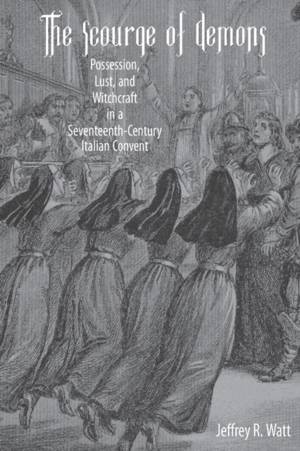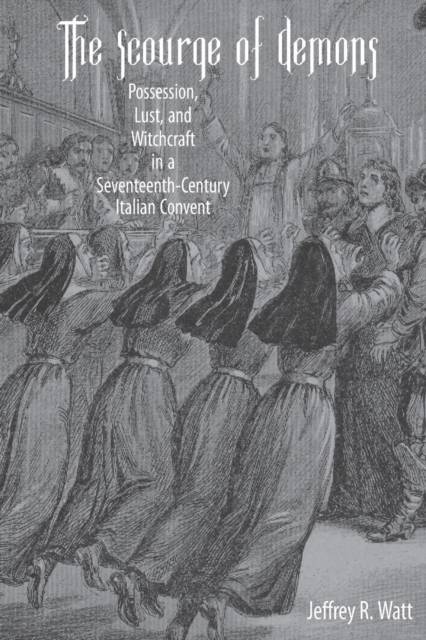
Bedankt voor het vertrouwen het afgelopen jaar! Om jou te bedanken bieden we GRATIS verzending (in België) aan op alles gedurende de hele maand januari.
- Afhalen na 1 uur in een winkel met voorraad
- In januari gratis thuislevering in België
- Ruim aanbod met 7 miljoen producten
Bedankt voor het vertrouwen het afgelopen jaar! Om jou te bedanken bieden we GRATIS verzending (in België) aan op alles gedurende de hele maand januari.
- Afhalen na 1 uur in een winkel met voorraad
- In januari gratis thuislevering in België
- Ruim aanbod met 7 miljoen producten
Zoeken
The Scourge of Demons
Possession, Lust, and Witchcraft in a Seventeenth-Century Italian Convent
Jeffrey R Watt
€ 56,45
+ 112 punten
Omschrijving
A fascinating examination of alleged demon possession and witchcraft in a seventeenth-century convent in Carpi, Italy. In 1636, residents at the convent of Santa Chiara in Carpi in northern Italy were struck by an extraordinary illness that provoked bizarre behavior. Eventually numbering fourteen, the afflicted nuns were subject to screaming fits, throwing themselves on the floor, and falling abruptly into a deep sleep. When medical experts' cures proved ineffective, exorcists ministered to the women and concluded that they were possessed by demons and the victims of witchcraft. Catering to women from elite families, the nunnery suffered much turmoil for three years and, remarkably, three of the victims died from their ills. A maverick nun and a former confessor were widely suspected to be responsible, through witchcraft, for these woes.
Based primarily on the exhaustive investigation by the Inquisition of Modena, The Scourge of Demons examines this fascinating case in its historical context. The travails of Santa Chiara occurred at a time when Europe witnessed peaks in both witch-hunting and in the numbers of people reputedly possessed by demons. Female religious figures appeared particularly prone to demonic attacks, and Counter-Reformation Church authorities were especially interested in imposing stricter discipline on convents. Watt carefully considers how the nuns of Santa Chiara understood and experienced alleged possession and witchcraft, concluding that Santa Chiara's diabolical troubles and their denouement -- involving the actions of nuns, confessors, inquisitorial authorities, and exorcists -- were profoundly shaped by the unique confluence of religious, cultural, judicial, andintellectual trends that flourished in the 1630s. Jeffrey R. Watt is professor of history at the University of Mississippi.
Based primarily on the exhaustive investigation by the Inquisition of Modena, The Scourge of Demons examines this fascinating case in its historical context. The travails of Santa Chiara occurred at a time when Europe witnessed peaks in both witch-hunting and in the numbers of people reputedly possessed by demons. Female religious figures appeared particularly prone to demonic attacks, and Counter-Reformation Church authorities were especially interested in imposing stricter discipline on convents. Watt carefully considers how the nuns of Santa Chiara understood and experienced alleged possession and witchcraft, concluding that Santa Chiara's diabolical troubles and their denouement -- involving the actions of nuns, confessors, inquisitorial authorities, and exorcists -- were profoundly shaped by the unique confluence of religious, cultural, judicial, andintellectual trends that flourished in the 1630s. Jeffrey R. Watt is professor of history at the University of Mississippi.
Specificaties
Betrokkenen
- Auteur(s):
- Uitgeverij:
Inhoud
- Aantal bladzijden:
- 312
- Taal:
- Engels
- Reeks:
Eigenschappen
- Productcode (EAN):
- 9781580465649
- Verschijningsdatum:
- 15/04/2016
- Uitvoering:
- Paperback
- Formaat:
- Trade paperback (VS)
- Afmetingen:
- 152 mm x 229 mm
- Gewicht:
- 462 g

Alleen bij Standaard Boekhandel
+ 112 punten op je klantenkaart van Standaard Boekhandel
Beoordelingen
We publiceren alleen reviews die voldoen aan de voorwaarden voor reviews. Bekijk onze voorwaarden voor reviews.









